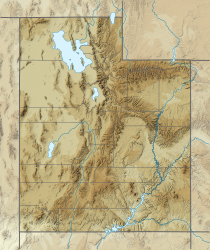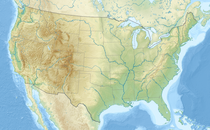The Titan is a 6,112-foot-elevation (1,863-meter) pillar in Grand County, Utah, United States.
| The Titan | |
|---|---|
 The Titan, south aspect | |
| Highest point | |
| Elevation | 6,112 ft (1,863 m)[1] |
| Prominence | 611 ft (186 m)Peak 6825[1] |
| Parent peak | Peak 6825[2] |
| Isolation | 0.56 mi (0.90 km)[2] |
| Coordinates | 38°43′01″N 109°17′58″W / 38.7170591°N 109.2995430°W[3] |
| Geography | |
| Country | United States |
| State | Utah |
| County | Grand |
| Parent range | Colorado Plateau[1] |
| Topo map | USGS Fisher Towers |
| Geology | |
| Rock age | Permian |
| Mountain type | Pillar |
| Rock type | Sandstone |
| Climbing | |
| First ascent | 1962 |
Description
editThe Titan is located 17 miles (27 km) northeast of Moab, Utah, in the Fisher Towers, on land administered by the Bureau of Land Management. It is the largest of the Fisher Towers which are near Castle Valley. The Titan is the steepest peak in the United States.[4] It has also been attributed to be the largest, free-standing, natural tower in the United States. The tower contains the Finger of Fate Route, first climbed in 1962, which is recognized in the historic climbing text Fifty Classic Climbs of North America and considered a classic around the world.[5][6][7][8] Topographic relief is significant as the summit rises 900 feet (274 meters) above the tower's base. Precipitation runoff from the tower drains to Onion Creek which empties into the Colorado River, approximately three miles to the west. Access is via Fisher Towers Road from Route 128 and hiking the Fisher Towers Trail. The Titan should not be confused with Titan Tower which is 0.8 mile to the east.[3][9]
Climbing
editThe first ascent of the summit was made on May 13, 1962, by Layton Kor, Huntley Ingalls, and George Hurley via the class 5.8 Finger of Fate route.[10]
Rock-climbing routes on The Titan:
- Finger of Fate - class 5.8 – Layton Kor, Huntley Ingalls, George Hurley – (1962)[11]
- Sundevil Chimney – class 5.9 – Harvey T. Carter, Tom Merrill, Bob Sullivan, Ken Wyrick – (1971)[12][13]
- Naked Lunch – class 5.10 – Duane Raleigh, Pete Takeda[14]
- World's End – Jim Beyer – (1986)[15]
- Gimp Warfare – class 5.8 – Paul Gagner, Jeremy Aslaksen – (2010)[16]
- Jade Gate – Jim Beyer[17]
Geology
editThe Titan is composed of sandstone and mudstone of the Permian Cutler Formation with an Early Triassic Moenkopi Formation caprock.[18] There is an unconformity between the Cutler and the Moenkopi layers.[19] The reddish coloration of the rock is a result of varying amounts of hematite.[20]
Climate
editSpring and fall are the most favorable seasons to visit The Titan. According to the Köppen climate classification system, it is located in a cold semi-arid climate zone with cold winters and hot summers.[21] Summers highs rarely exceed 100 °F (38 °C). Summer nights are comfortably cool, and temperatures drop quickly after sunset. Winters are cold, but daytime highs are usually above freezing. Winter temperatures below 0 °F (−18 °C) are uncommon, though possible. This desert climate receives less than 10 inches (250 millimeters) of annual rainfall, and snowfall is generally light during the winter.
See also
editGallery
editReferences
edit- ^ a b c "The Titan". Peakbagger.com. Retrieved 2024-09-14.
- ^ a b "Titan, The - 6,113' UT". listsofjohn.com. Retrieved 2024-09-14.
- ^ a b "The Titan". Geographic Names Information System. United States Geological Survey, United States Department of the Interior. Retrieved 2024-09-14.
- ^ Contiguous US Steepness List, listsofjohn.com, Retrieved 2024-09-14.
- ^ Roper, Steve; Steck, Allen (1979). Fifty Classic Climbs of North America. San Francisco: Sierra Club Books. pp. 217–220. ISBN 0-87156-292-8.
- ^ McDonald, Dougald; Chris McNamara (2002). Desert Towers Select. Supertopo LLC.
- ^ Bjornstad, Eric (1999). Desert Rock III. Helena, MO: Chockstone, Falcon. ISBN 1-56044-754-0.
- ^ Knapp, Fred (2002). Classic Desert Climbs (second ed.). Sharp End Publishing. ISBN 1-892540-17-7.
- ^ "Titan Tower". Geographic Names Information System. United States Geological Survey, United States Department of the Interior. Retrieved 2024-09-14.
- ^ First Ascent Timeline, deserttowersbook.com, Retrieved 2024-09-14.
- ^ Finger of Fate, Mountain Project, Retrieved 2024-09-14.
- ^ Cameron Burns, Selected Climbs in the Desert Southwest: Colorado and Utah, The Mountaineers Books, 1999, ISBN 9780898866575, p. 78.
- ^ Sundevil Chimney, Mountain Project, Retrieved 2024-09-14.
- ^ Naked Lunch, Mountain Project, Retrieved 2024-09-14.
- ^ World's End, Mountain Project, Retrieved 2024-09-14.
- ^ Gimp Warfare, Mountain Project, Retrieved 2024-09-14.
- ^ Jade Gate, Mountain Project, Retrieved 2024-09-14.
- ^ Castle Valley Overview United States of America, Virtual 3D Geoscience, v3geo.com, Retrieved 2024-09-05.
- ^ Castle Valley Overview United States of America, Virtual 3D Geoscience, v3geo.com, Retrieved 2024-09-05.
- ^ GeoSights: Fisher Towers – The towering red rock sculptures of Grand County, Utah, Carl Ege, Utah Geological Survey, Retrieved 2024-09-12.
- ^ Peel, M. C.; Finlayson, B. L. & McMahon, T. A. (2007). "Updated world map of the Köppen−Geiger climate classification". Hydrol. Earth Syst. Sci. 11 (5): 1633–1644. Bibcode:2007HESS...11.1633P. doi:10.5194/hess-11-1633-2007. ISSN 1027-5606. S2CID 9654551.
External links
edit- Weather forecast: Fisher Towers
- The Titan Rock Climbing: Mountainproject.com

